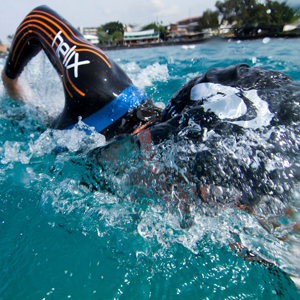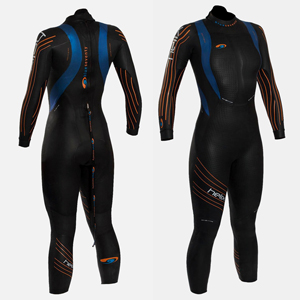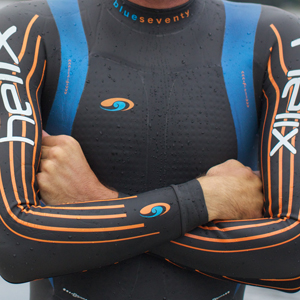blueseventy Helix (2012)

The 2012 blueseventy Helix is a suit redesigned from last year. Which surprised me because, honestly, the 2011 Helix was in the upper echelon of all fullsuits I tested in the water (about 10 or 12) during 2011. I could not conceive of much in the 2011 version I'd want to change.
The new Helix differs in several ways from its antecedent, but, what does not change is the superior engineering and attention to detail in the neck, the zipper, and other troublesome areas that prove the weak link in many wetsuit designs.
The hand entry is also unchanged from last year, and this is a signature departure in the Helix from many, most or all other wetsuits. Rather than building the forearm up with one sort of pulling panel or another, the Helix goes minimal, and even features the lack of any rubber—placing Lycra (or its equal) in its place—in some parts of the forearm. The wrist is impervious to water, and will appeal to those who want a no-wetsuit feel in a fullsuit.
The Helix features a reverse zipper, meaning the zipper zips from the top down (the zipper slides down to as you prepare to swim, and you then zip it up to get out of the suit). The advantage to this is that the zipper cannot pull down in the water (i.e., cannot be pulled down inadvertently or otherwise by a fellow competitor). The disadvantage is that it's harder to put the wetsuit on by yourself. I frankly like the standard zippers better. But I stipulate to the reasoning.

My personal impression? And for this section, I'll refer to the tale of two torsos. I like last year's Helix better. The difference is in the fit. I'm just over 6'1" and I'm slightly long in the torso. I find the new Helix pattern reminiscent of the Orca patters during the 90s and the aughts: best made for long-legged, short- or average-torso morphologies.
On the flip side, the Helix in that same size seems to nicely fit Lance Armstrong, who swam in it over the weekend in the Galveston 70.3 and emerged in the front pack. He and I are the same weight, but he's 3 inches shorter than I am. He's also leggy. So, his torso is considerably shorter than mine.
But, since he's shorter, where's the extra weight? His chest is bigger than mine. So, was the Helix too tight in the chest for him?
This brings us to the big difference between this and last year's Helix. When I first got the wetsuit, it looked a lot to me like a technique employed by my former right hand gal at Quintana Roo, Karen Sing. During the diaspora of my old staff, she ended up at Zoot (she's now at Profile Design), and the Zoot suit she designed was made entirely of thin rubber (2mm or thereabouts), with thicker panels sewed inside in strategic areas that conspired to make the suit 5mm thick sorta kinda throughout, but strategically-placed 2mm-thick stretch panels interspersed.
The new Helix appears to be made like this, but in reality the suit is more conventional in its construction, with panels of various thicknesses butted and mated. What you'll note in the new Helix is a very thin center channel moving from just below the neck to around the sternum. The rubber in this channel is only 2.5mm thick. It's made of hyper-stretchy Yamamoto #40 rubber with very stretchy nylon jersey attached. This splits the 5mm panels of high-float Aerodome rubber, and this is what allows a barrel-chested swimmer like Armstrong to wear a suit that might otherwise seem chest-tight to him.

Back to the fit. Why is this suit short in the torso versus last year's suit? It might be just a change in pattern. However, a wetsuit maker will notice that his wetsuits will change in their fit characteristics without any pattern change at all. Of course, changing the stretchability in the rubber or adhered jersey will impact the fit of the suit. But there is another factor: Seams inhibit flex, particularly along the bias of the seam. So, can the very feature that makes the suit flexible in the chest widthwise inhibit its flexibility lengthwise? This Helix features, as noted, a pair of seams that run vertically, in the front of this suit, all for a stretch panel making this suit very workable for those who don't need a lot of torso length, but who need torso width without bagginess. But, these vertical seams—unless they're zigzag seams with stretchable thread (which they are not and would be impractical considering the nature of this suit's construction)—may challenge those who need vertical compliance.
The blueseventy Helix is a $650 fullsuit. It's also made in a sleeveless version which, as you might guess if you're a Slowtwitch reader, is a nonsensical version. Sleeveless wetsuits are made for the bargain hunters, or those who somehow find themselves in a wetsuit-legal race that has no business being wetsuit legal. If you bought the 6-cylinder motor when you bought your new Dodge Challenger, then, maybe consider the sleeveless Helix. Otherwise, go straight to the fullsuit—the Helix is a muscle car, it's a crime to defile it by lopping off the sleeves.
This ought to remind us all that there is nothing triathletes use—not bikes, or bibs or skinsuits or helmets—that are as fit-fickle as wetsuits. A constant refrain is "buy the bike that fits." How much more so with wetsuits? If expertly made suits like this new Helix fall into this category, how much more important is it to make sure the suit fits, taking into consideration that there are wetsuits out there that will fit no one well, because they are not as expertly made as this Helix?




Start the discussion at forum.slowtwitch.com